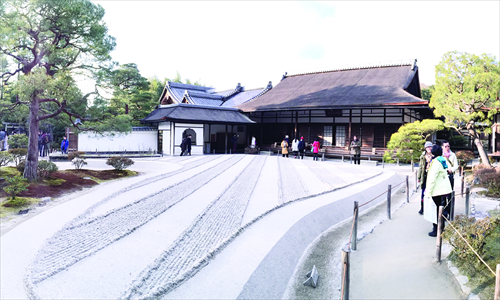
Visitors sightsee the rock garden at the Ginkakuji Temple in Kyoto, Japan. Photo: GT/Chu Daye
This January, I had the opportunity to embark on a tour to Japan, a modern country with a rich history that's just a three-hour flight from Beijing. Before the trip, my impression of the country was mostly based on blockbusters such as Memoirs of a Geisha and The Last Samurai.
Having decided not to spread my four-day holiday too thinly across Japan, I chose to focus on the city of Kyoto located in Japan's Kansai region. The region is a rather famous place for those who only have a short time at their disposal. It offers the combined package of the culture of Kyoto, the cosmopolitanism of Kobe and the mercantilism of Osaka.
Traveling on the Japanese Railway
The Kansai International Airport was built on a piece of land entirely reclaimed from the Seto Inland Sea. It was from here that I would head to first city on my tour: Kyoto, Japan's ancient capital. However, to leave the airport I had to deal with, for the first time, Japan's very sophisticated rail system.
Actually, I found many systems in Japan are quite sophisticated, from the railway system to bus route signboards. Such a thing is a blessing for local residents and those who can read Japanese but can well be a nightmare for those who just arrived and are linguistically ill-prepared. It turned out that the rail service is run by several companies, state-owned and private, and they often have different departure stations built close to each other. You definitely have to do some homework to avoid stepping onto the wrong train.
On the bright side, I found that commerce flourished around the train stations. China, which has the world's largest high-speed railway system and is working on developing commerce along railways, can surely learn something from the way rail arteries boost commerce. In the three cities I traveled through, dozens of shopping malls were built directly attached or with direct shortcuts to train stations in order to be close to passengers. From what I saw, business was booming in these bustling complexes.
Embarking on the Haruka express train, which started from Kansai Airport and went pass Osaka, I arrived in the Kyoto railway station in less than 80 minutes. The Haruka train's locomotive is like a warrior in a blue helmet, distinguishing itself from other trains of a different speed class or from other companies, and I found out later that it even has its own action figure!
The familiar in the unfamiliar
It was already dark when I arrived in Kyoto, but trotting along the city's streets, I still got to see the dim silhouette of several temples and monasteries. Temples, monasteries, pagodas, and shrines, all these are major elements in Kyoto. There were so many of them! These venues are what helped make the city the capital of Japan before Tokyo took over.
Since many Kanji characters in Japanese were borrowed from Chinese, I was able to read a lot of the street names in Kyoto. I found that they were very similar to street names of alleyways in Beijing. This gave me a sense of familiarity and comfort, a feeling that I was not traveling in an entirely "foreign" country.
Coming across an "izakaya" (Japanese-style tavern) whose name in Chinese translates as "Bird of a Hundred Miles," you can expect to have a taste of roasted chicken over a few cups of draft beer, while at a roadside convenience store that means "canteen" in Chinese, you can expect to see what Japanese white-collar workers have for lunch.
Commercial delights
I spent three days in Kyoto, during which time I visited the Kiyomizu-dera Temple and its surroundings, the Fushimi Inari Shrine (the setting for some scenes in Memoirs of a Geisha), and the Ginkakuji Temple (Temple of the Silver Pavilion). Throwing in some other attractions on my itinerary, I was, on average, visiting two world cultural heritage sites a day.
The Kiyomizu-dera Temple takes its name from the waterfall located within the temple complex. Kiyomizu means "clear water" or "pure water" in Japanese. Wrapped in sunlight, the entire neighborhood that leads to the temple was really impressive. The uphill, winding streets were lined with all kinds of shops inside traditional Japanese houses. Walking through the area could easily take up an entire day if you wanted it to.
Although very commercialized, there were strong local cultural elements that were very noticeable.
To name a few things that hooked me, one was a chopstick shop selling hundreds of different types of chopsticks. The chopsticks came in different shapes, materials and even were designed for different uses. After choosing my favorite pair, the shop carved my name on the chopsticks for free! In just five minutes, my chopsticks were marked with my name in golden traditional Chinese characters!
Encountering the Zen spirit
Another discovery, made while visiting a wildly popular local Matcha biscuits shop, was the "refined little worlds" that exist in many Japanese people's courtyards. I first discovered one of these courtyards at the biscuit shop, but later on I saw so many of them that I came to the conclusion that they must be a common feature of the Japanese lifestyle.
The inner space of the Matcha shop was long and narrow but the owner still dedicated a considerable amount of space for a courtyard, which was surrounded on three sides by transparent flat glass and the wall of the next shop on the fourth side. The courtyard could be accessed via a small door linked to the shop's interior. A miniature scene composed of mountains and waterfall was the theme of this courtyard, projecting a concise sense of the spirit of Zen.
Just a few yards away, a crowd of customers were busy buying things in the shop, whereas the courtyard, situated in the middle section of the narrow shop interior, provided a definite escape from the world as it pulls your thoughts away from worldly pursuits and focuses them on a world that is more spiritual and refined.
As I continued my tour, similar refined courtyards appeared. I could easily tell that their owners were constantly putting in tremendous effort to keep their little courtyards super tidy and clean - gravel was always carefully spread out, the plants or bonsai meticulously groomed and the grass and moss neatly trimmed. In some of the more lovely cases, some figurines (in the case of Kyoto, an anthropomorphic beaver) were on display. The figures were so cute that I wondered if they were meant to make viewers smile or were they rather supposed to be the masters of these carefully created little worlds?
Another place to see some Zen spirit is Kyoto's Ginkakuji Temple. One of the features of the temple is the Japanese rock garden in which gravel has been used to form a miniature Mt. Fuji. But almost as important as Ginkakuji Temple is a nearby mountain trail known as the Philosopher's Road, which you can take to view cherry blossoms.
The two sights are located together so can be seen in one go. The Philosopher's Road is a pebble trail that runs parallel to a ditch at the foot of a mountain. The trail leads to several other temples and shrines on the mountain, while rows of cherry trees have been planted along the banks of the ditch. In Spring, the pink blossom of the cherry trees strike a sharp contrast with the budding greenery of the mountain, making the Philosopher's Road one of the best destinations for cherry blossom sightseeing.
Although it was winter time when I visited, I still felt quite relaxed while taking a brisk walk along the trail and contemplated on one of the predominant themes for traveling in Kyoto - the coexistence of man and nature and the seamless transition from dazzling urban life to a quiet rural setting.
Rules of thumb
1. Not too far from Kyoto is Himeji, the seat of a world-class castle that was once the home of a local warlord, and Nara, another ancient capital of Japan. The convenient rail travel in Japan means you can plan a single day trip to these locations.
2. One famous hot spring, the Arima Onsen, can be easily reached from Kyoto. It can make for a great one night stay experience that will leave plenty of time to visit the quaint mountain villages. You can also take a trip up the mountain via cable car to take in what is said to be a million-dollar panoramic view from the top of Mount Rokko.

